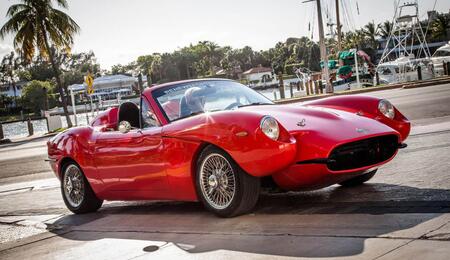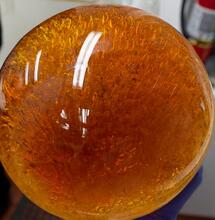Key West man riding high in ‘Cannabis Car

A sports car made from cannabis hemp could lead the charge in making carbon neutral vehicles. Made from the chassis of a Mazda convertible, the hemp car is bringing a new meaning to the phrase ‘green machine’ and could soon be seen on high roads around the world. Barcroft TV Klik on Photo to watch Video Pot brownie, meet the Cannabis Car.
A Key West man has become the latest, though not the first, to extol another wonder of the miracle plant: a car mostly made of hemp that he says can cut the carbon footprint of the planet’s estimated 1 billion cars and cover much-needed ground in the fight against climate change. But a warning to Cheech and Chong fans: You can’t smoke this car. (For all you youngsters, the ’70s stoner duo unwittingly stole a van made of ganja in the movie Up In Smoke, only to crash and have it ignite. You can guess the rest.)
Theoretically, you can smoke anything you want to, but it would not be good idea.
Bruce Dietzen, president Renew Sports Cars“Theoretically, you can smoke anything you want to, but it would not be a good idea,” said Bruce Dietzen, president of Renew Sports Cars, who says he regularly gets asked if he smokes marijuana.
For the record, he does not. And also for the record, the car is made of hemp, a less-potent cousin of marijuana that for thousands of years has been used to make rope and now a fiberglass-like plastic. Dietzen, a retired Dell computer salesman, completed the car in his garage last year after moving to the island 16 years ago with a mini fleet of sports cars, mostly curvy Italian and British classics from the ’50s that served as his models. Using the chassis of a Mazda, Dietzen built the zippy red Cannabis Car from about 100 pounds of imported Chinese hemp. Woody material from inside the hemp stalk is combined with a resin to form a kind of super-strong plastic that is then molded into a car body.
$40,000Starting cost for an entry-level Canna 255 with a 4-cylinder engine
Dietzen says he will take custom orders for the cars — prices range from $40,000 for a 130-horsepower model and go as high as $197,000 for a 2,300-pound edition powered by a fire-breathing 640-horse engine. But he stresses that he is less interested in founding the next big eco car company than in providing inspiration for existing ones.
“All I want to do is build one car at a time, one day at a time,” said Dietzen, who in September drove to Chicago to show off the car at Willie Nelson’s 30th annual Farm Aid benefit concert. “I’m 61. I’m not going to go out there and get a bunch of people for financing who want to make quarterly numbers, because that’s a good way to sink a company. I’m doing it out of my belief in what needs to be done,” he said. “I didn’t want to look at the end of my career and say, wow, I sold a bunch of computers.” Dietzen believes his car may be the only hemp car now in production, though by no means the first. In 1941, Henry Ford unveiled the Soybean Car.
But production was derailed when World War II broke out. Exact ingredients aren’t known, though Ford historians believe the car was constructed of hemp, wheat straw and flax held together by a soybean-based resin. “It’s not that he cared about the environment, but because he was raised on a farm, he loved farmers, and the farmers back then were in as bad a shape as they are today,” Dietzen said. Hemp farming in the U.S. also hit a snag for several decades as opposition to marijuana spread.
Still, hemp use in the U.S. never disappeared. In 2015, the industry estimated U.S. sales at about $580 million annually. With the rise in the legalization of marijuana and the government in 2014 agreeing to some pilot hemp-farming programs, there is talk of a return to industrialized hemp farming.
What intrigued Dietzen was the flexibility of using cannabis-based hemp, and its strength. Nearly every piece of his car that could be made of hemp is, including the body, dash and rugs. Engine parts, the car frame, windshield switches and other mechanical and electrical parts are not. Manufacturing a car from cannabis, and fueling it with biofuels, could have huge carbon rewards, he said.
You have a car operating in a carbon-negative environment.
Bruce Dietzen, president Renew Sports Cars “You have a car operating in a carbon negative environment,” he said. But so far, the idea has failed to catch on in the mainstream car-manufacturing world. In 2008, Lotus unveiled the hemp-bodied Eco Elise, but it remains a “concept car” not in production. The Canadian-made Kestrel also failed to make it onto assembly lines. European manufacturers, who pay big disposal fees for dumping rusting metal cars, have embraced more hemp in cars, but only for parts of cars. Still, five years after Mercedes-Benz introduced a jute-based door panel, the use of natural fibers in German-made cars has tripled.
So, how ready is the world for a weed wagon or a Maui Wowie minivan? Dietzen is working on a second car — he won’t say if it’s a custom order — and plans on dropping by Ford headquarters when he drives to the Cannabis Cup in Clio, Michigan, in June.
He’s in talks with Cool Planet, a Colorado tech company developing carbon-negative fuels, and is in the midst of filming segments for a documentary produced by Diana Oliver, who created Hempsters Plant the Seed, featuring Woody Harrelson. “Every bit of plastic in the world can be made from hemp instead of oil, and it needs to be,” Dietzen said. “It’s one of the big ways we’re going to reverse climate change.” SOURCE



